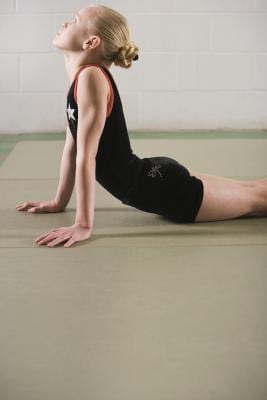Gymnastics is a sport that is ideal for kids; it offers equal opportunities for both boys and girls. Also, many kids, especially younger ones, seem naturally inclined to roll, tumble and somersault their way across gym floors and playgrounds. Monkey bars on playgrounds can provide the inspiration for gymnastics bar routines. Because almost all muscles are used in gymnastics routines, exercises designed to increase muscle strength help kids improve their gymnastics routines.
Triceps Exercise
For this exercise, stand in front of a kitchen table chair, facing away from the chair. Scoot your feet forward and lean back, placing your hands about shoulder-width apart on the chair seat. Your arms should be supporting your entire weight, and your shoulders should be directly above your hands. Slowly lower yourself so that your body passes down in front of the chair and then raise yourself until your arms are straight. During this lowering and raising of your body, your feet should not move and your hips should not touch the floor. Standard push-ups also exercise the triceps muscles.
Abdominal Exercises
Lie flat on your back. The use of a floor mat, gymnastics pad or a rug can help make this exercise more comfortable when performed at home. Raise your legs and your arms off the floor and hold the position for 30 seconds. There are variations of this exercise that can be considered more difficult. For example, you could hold your arms low, with hands near the hips, or you can hold your arms high, over your head, which is more difficult and will cause muscles to work harder. Legs can be kept straight, or you can raise them into a tuck position with your hands holding onto your knees.
Calves and Ankles Exercises
For this exercise, you’ll need a low beam, which is a gymnastics piece of equipment, or a simple raised structure such as a four-by-four piece of wood. Place the beam or wood near a wall so that the wall can be used for maintaining balance. Stand on the beam or the support structure so that your heels hang over the edge of the structure and the balls of your feet are on the structure and you are facing the wall. Lower and raise your heels below and above the top level of the beam or wood, going as high and as low as possible.





